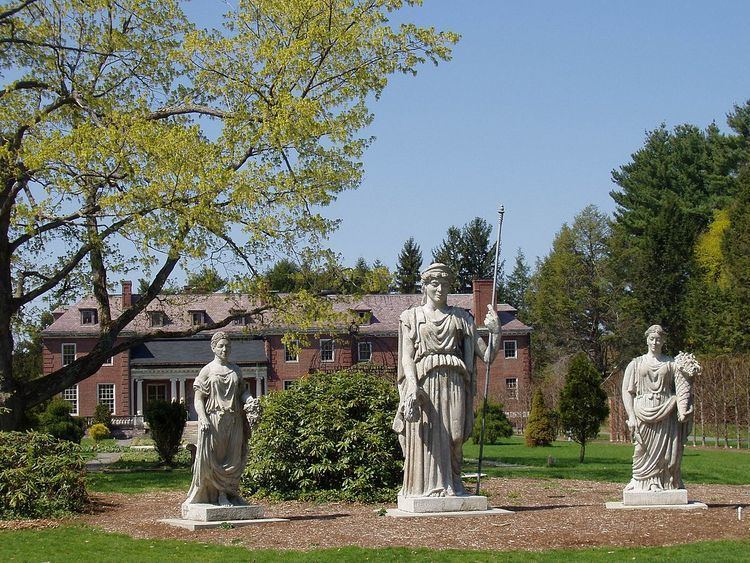Area 182 acres (74 ha) NRHP Reference # 86003565 | Built 1876 | |
 | ||
Location Bounded by the Charles River to the W, N, and E, and the carriage path to the S, off 900 Washington St., Dover, Massachusetts Architectural style Late 19th and 20th Century Revivals, Neo-Georgian; Georgian Rev. | ||
The Elm Bank Horticulture Center, home of the Massachusetts Horticultural Society, occupies 36 acres (15 ha) of Elm Bank Reservation, a 175-acre (71 ha) recreational area of woodlands, fields, and former estate property on the Charles River managed by the Massachusetts Department of Conservation and Recreation. The estate's entrance is located at 900 Washington Street (Route 16), Wellesley, Massachusetts, United States, with the major portion of the grounds located in the neighboring town of Dover. In 1987, the entire site was added to the National Register of Historic Places as Elm Bank.
Contents
History
Property records date back to 1732 when Thomas Fuller owned the tract on land then known as the Natick Plain. The property earned the sobriquet Elm Bank after Colonel John Jones acquired the land in 1740 and planted elm trees along the riverside. After being occupied by families named Loring, Broad, and Otis, the property was sold for $10,000 in 1874 to Benjamin Pierce Cheney, a founder of a delivery company that became American Express. At the time of Cheney's death in 1895, the property contained over 200 acres (80 hectares), and passed to his eldest daughter Alice in 1905. In 1907, Alice and her husband, Dr. William Hewson Baltzell, engaged the architectural firm of Carrère and Hastings to design a Neo-Georgian manor house. They also commissioned the Olmsted Brothers firm, the most prominent landscape designers of the era, for the estate's site planning and to design new gardens and improve existing ones. In the 1940s, the property became a seminary housing a group of Stigmatine Fathers, who constructed a school building and ran a summer camp in the 1960s and 70s. The Commonwealth of Massachusetts purchased the property in the mid 1970s. It then served as the home of the Quinobin Regional Technical School.
In 1996, 36 acres (15 ha) were leased to the Massachusetts Horticultural Society for a term of 100 years. The society began to charge non-member visitors an entrance fee in 2010, which was US$8 as of 2015. The gardens' preservation is also supported through special events and private usages such as garden weddings.
Gardens
The distinct gardens featured at Elm Bank include:
A series of small spiraling gardens, each giving visitors the opportunity to plant, water or interact in some way with the garden’s elements. Children’s classes are held throughout the spring, summer and fall in this special garden.
A cooperative effort between the University of Massachusetts, the Massachusetts Flower Growers’ Association and the Massachusetts Horticultural Society. Breeding companies from all over the world contribute Annuals for viewing by amateur and professional Gardeners. This garden also tests unreleased varieties competing for All-America Selections awards, displays previous winners, and grows hundreds of cultivars submitted for evaluation by commercial plant breeders.
Restoration of the 1926 Italianate Garden was based on the original plans from the Frederick Law Olmsted National Historic Site, together with a numbered plant list - and even receipts - for the original trees and flowers planted in the garden.
The Noanett Garden Club, the New England Chapter of the Herb Society of America, and the American Rhododendron Society maintain collaborative demonstration and display gardens at Elm Bank. The Day Lily Society installed a garden in 2004.
